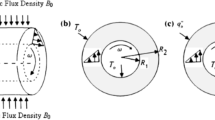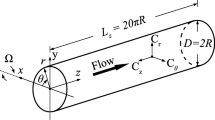Abstract
Three-dimensional direct numerical simulations of a solid-body rotation superposed on a uniform axial flow entering a rotating constant-area pipe of finite length are presented. Steady in time profiles of the radial, axial, and circumferential velocities are imposed at the pipe inlet. Convective boundary conditions are imposed at the pipe outlet. The Wang and Rusak (Phys. Fluids 8:1007–1016, 1996. doi:10.1063/1.86882) axisymmetric instability mechanism is retrieved at certain operational conditions in terms of incoming flow swirl levels and the Reynolds number. However, at other operational conditions there exists a dominant, three-dimensional spiral type of instability mode that is consistent with the linear stability theory of Wang et al. (J. Fluid Mech. 797: 284–321, 2016). The growth of this mode leads to a spiral type of flow roll-up that subsequently nonlinearly saturates on a large amplitude rotating spiral wave. The energy transfer mechanism between the bulk of the flow and the perturbations is studied by the Reynolds-Orr equation. The production or loss of the perturbation kinetic energy is combined of three components: the viscous loss, the convective loss at the pipe outlet, and the gain of energy at the outlet through the work done by the pressure perturbation. The energy transfer in the nonlinear stage is shown to be a natural extension of the linear stage with a nonlinear saturated process.







Similar content being viewed by others
References
Sarpkaya, T.: On stationary and traveling vortex breakdowns. J. Fluid Mech. 45, 545–559 (1971). doi:10.1017/S0022112071000181
Sarpkaya, T.: Effect of the adverse pressure gradient on vortex breakdown. AIAA J. 12, 602–607 (1974). doi:10.2514/3.49305
Faler, J.H., Leibovich, S.: Disrupted states of vortex flow and vortex breakdown. Phys. Fluids 20, 1385–1400 (1977). doi:10.1063/1.862033
Garg, A.K., Leibovich, S.: Spectral characteristics of vortex breakdown flowfields. Phys. Fluids 22, 2053–2064 (1979). doi:10.1063/1.862514
Leibovich, S.: Vortex stability and breakdown: survey and extension. AIAA J. 22, 1192–1206 (1984). doi:10.2514/3.8761
Brucker, Ch., Althaus, W.: Study of vortex breakdown by particle tracking velocimetry (PTV). Part 3: time-dependent structure and development of breakdown modes. Exp. Fluids 18, 174–186 (1995). doi:10.1007/BF00230262
Mattner, T.W., Joubert, P.N., Chong, M.S.: Vortical flow. Part 1. Flow through a constant-diameter pipe. J. Fluid Mech. 463, 259–291 (2002). doi:10.1017/S0022112002008741
Liang, H.Z., Maxworthy, T.: An experimental investigation of swirling jets. J. Fluid Mech. 525, 115–159 (2005). doi:10.1017/S0022112004002629
Umeh, C., Rusak, Z., Gutmark, E., et al.: Experimental and computational study of nonreacting vortex breakdown in a swirl-stabilized combustor. AIAA J. 48, 2576–2585 (2010). doi:10.2514/1.J050393
Rusak, Z., Wasserstrom, E., Seginer, A.: Numerical calculation of nonlinear aerodynamics of wing-body configurations. AIAA J. 21, 929–936 (1983). doi:10.2514/3.8179
Er-El, J., Seginer, A.: Vortex trajectories and breakdown on wing-canard configurations. J. Aircr. 22, 641–648 (1985). doi:10.2514/3.45180
Rusak, Z.: Review of recent studies on the axisymmetric vortex breakdown phenomenon. In: Fluids 2000 Conference and Exhibit, Denver, Colorado, AIAA-2000–2529 (2000)
Benjamin, T.B.: Theory of the vortex breakdown phenomenon. J. Fluid Mech. 14, 593–629 (1962)
Randall, J.D., Leibovich, S.: The critical state: a trapped wave model of vortex breakdown. J. Fluid Mech. 58, 495–515 (1973)
Keller, J.J., Egli, W., Exley, W.: Force- and loss- free transitions between flow states. Z. Angrew. Math. Phys. 36, 854–889 (1985). doi:10.1007/BF00944899
Leibovich, S., Kribus, A.: Large amplitude wavetrains and solitary waves in vortices. J. Fluid Mech. 216, 459–504 (1990). doi:10.1017/S0022112090000507
Kelvin, L.: Vibrations of a columnar vortex. Phil. Mag. 10, 155–168 (1880)
Rayleigh, L.: On the dynamics of revolving fluids. Proc. R. Soc. Lond. Ser. A 93, 148–154 (1917)
Synge, J.L.: The stability of heterogeneous liquids. Trans. R. Soc. Can. 27, 1–18 (1933)
Howard, L.N., Gupta, A.S.: On the hydrodynamics and hydromagnetic stability of swirling flows. J. Fluid Mech. 14, 463–476 (1962)
Lessen, H., Singh, P.J., Paillet, F.: The stability of a trailing line vortex. Part 1. Inviscid theory. J. Fluid Mech. 63, 753–763 (1974)
Leibovich, S., Stewartson, K.: A sufficeint condition for the instability of columnar vortices. J. Fluid Mech. 126, 335–356 (1983)
Ash, R.L., Khorrami, M.R.: Vortex Stability. Chapter 8 in: Fluid Vortices. Klumer Academic Publishes, Netherlands, 317–372 (1995)
Wang, S.X., Rusak, Z.: On the stability of an axisymmetric rotating flow in a pipe. Phys. Fluids 8, 1007–1016 (1996). doi:10.1063/1.86882
Wang, S.X., Rusak, Z.: The dynamics of a swirling flow in a pipe and transition to axisymmetric vortex breakdown. J. Fluid Mech. 340, 177–223 (1997)
Wang, S.X., Rusak, Z.: Energy transfer mechanism of the instability of an axisymmetric swirling flow in a finite-length pipe. J. Fluid Mech. 679, 505–543 (2011). doi:10.1017/jfm.2011.143
Rusak, Z., Wang, S.X., Xu, L., et al.: On the global nonlinear stability of near-critical swirling flows in a long finite-length pipe and the path to vortex breakdown. J. Fluid Mech. 712, 295–326 (2012). doi:10.1017/jfm.2012.420
Wang, S.X., Rusak, Z., Gong, R., et al.: On the three-dimensional stability of a solid-body rotation flow in a finite-length rotating pipe. J. Fluid Mech. 797, 284–321 (2016)
Salvetti, M.V., Orlandi, P., Verzicco, R.: Numerical simulations of transitional axisymmetric coaxial jets. AIAA J. 34, 736–743 (1996). doi:10.2514/3.13134
Verzicco, R., Orlandi, P.: A finite-difference scheme for three-dimensional incompressible flows in cylindrical coordinates. J. Comput. Phys. 123, 402–414 (1996)
Ruith, M.R., Chen, P., Meiburg, E., et al.: Three-dimensional vortex breakdown in swirling jets and wakes: direct numerical simulation. J. Fluid Mech. 486, 331–378 (2003)
He, G.W., Rubinstein, R.: Effects of subgrid-scale modeling on time correlations in large eddy simulation. Phys. Fluids 14, 2186–2193 (2002)
Yang, Y., He, G.W., Wang, L.P.: Effects of subgrid-scale modeling on Lagrangian statistics in large eddy simulation. J. Turbul. 9, 1–24 (2008)
Jin, G.D., He, G.W., Wang, L.P.: Large-eddy simulation of turbulent-collision of heavy particles in isotropic turbulence. Phys. Fluids 22, 055106 (2010)
Zhao, X., He, G.W.: Space-time correlations of fluctuating velocities in turbulent shear flows. Phys. Rev. E 79, 046316 (2009)
Feng, C., Liu, F., Rusak, Z., et al.: On the three-dimensional dynamics of a perturbed solid-body rotation flow in a finite-length pipe. J. Northwest. Polytech. Univ. 33, 211–222 (2015)
Rusak, Z., Wang, S.X.: Wall-separation and vortex-breakdown zones in a solid-body rotation flow in a rotating finite-length straight circular pipe. J. Fluid Mech. 759, 321–359 (2014)
Rusak, Z., Wang, S.X.: Review of theoretical approaches to the vortex breakdown phenomenon. In: AIAA 1st Theoretical Fluid Mechanics Meeting, New Orleans, LA, AIAA-1996-2126 (1996)
Wu, J.Z., Ma, H.Y., Zhou, M.D.: Vorticity and Vortex Dynamics. Springer, Berlin (2006)
Acknowledgements
The project was supported by the Young Scientists Fund of the National Natural Science Foundation of China (Grant 11601411) and the Scientific Research Program Funded by Shannxi Provincial Education Department (Grant 15JK1313).
Author information
Authors and Affiliations
Corresponding author
Rights and permissions
About this article
Cite this article
Feng, C., Liu, F., Rusak, Z. et al. The energy transfer mechanism of a perturbed solid-body rotation flow in a rotating pipe. Acta Mech. Sin. 33, 274–283 (2017). https://doi.org/10.1007/s10409-017-0642-2
Received:
Revised:
Accepted:
Published:
Issue Date:
DOI: https://doi.org/10.1007/s10409-017-0642-2




